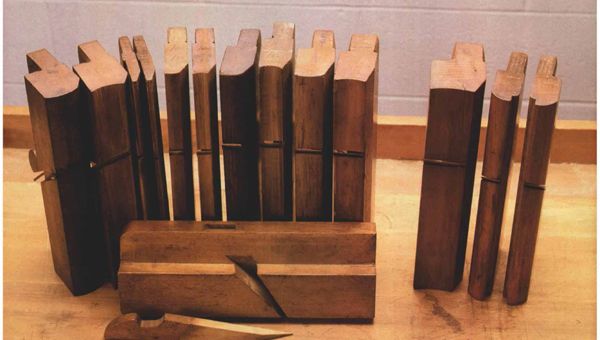
Synopsis: In the family of molding planes, hollows and rounds are often considered the poor relations. They duplicate moldings made by specialized molding planes, but they also are used to complete and trim moldings, for sculptural shaping, and for working hollow and round shapes in their own right, such as linenfold paneling. In this article, Graham Blackburn talks about the varieties of these planes and how to shop for them. He also reveals their “secret” value in a workshop: because they are made in pairs, they can be “reversed” if grain direction changes, thereby minimizing tearout.
Of all the wooden molding planes that are still to be found in antique shops, at flea markets and at the back of many workshops, the hollow plane, and its mate the round plane, are among the commonest. They hardly appear at first glance to be among the most useful of tools, but their relative abundance is an indication of the important position they once held in many woodworkers’ tool kits. I well remember, as a boy in England, seeing rows of them in my school workshop and watching with fascination as they were used for all manner of work. Today, more than 30 of them have a place in my own workshop and find frequent employment in my custom-furniture business. The photo above shows a good range of sizes, from a variety of makers here and abroad. While these are by no means a complete set of graduations, these are typical of what you might easily find for sale, and a selection such as this is sufficient to accomplish most of the purposes I will discuss in this article.
Hollows and rounds are often represented as being the poor relations in the family of molding planes. While other molding planes—the ogees, the cavettos, the astragals and the beading planes, for example—all cut a distinct molding, the hollows and rounds are said to be used only in lieu of a more particular plane, in a makeshift effort to reproduce the desired molding. While it is true that hollows and rounds can duplicate moldings made by specialized molding planes, this is by no means their only job. They are also invaluable for completing and trimming moldings begun by more specific planes, for sculptural shaping, and for working hollow and round shapes in their own right—of which perhaps the crowning example is linenfold paneling (see FWW #36 or FWW on Carving).
From Fine Woodworking #69
For the full article, download the PDF below:
Fine Woodworking Recommended Products

Starrett 12-in. combination square

Veritas Micro-Adjust Wheel Marking Gauge

Veritas Wheel Marking Gauge




















Log in or create an account to post a comment.
Sign up Log in